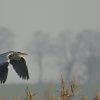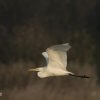GREAT EGRET, ARDEA ALBA, CZAPLA BIAŁA
- Aperture: ƒ/9
- Camera: NIKON D5200
- Exposure bias: +4/6EV
- Focal length: 850mm
- ISO: 800
- Shutter speed: 1/1000s
Szczudłak zwyczajny, great egret – Ardea alba, also known as the common egret, large egret, great white egret or great white heron is a large, widely distributed egret, with four subspecies found in Asia, Africa, the Americas, and southern Europe. Distributed across most of the tropical and warmer temperate regions of the world. It builds tree nests in colonies close to water. Like all egrets, it is a member of the heron family, Ardeidae.
The great egret is a large heron with all-white plumage. Standing up to 1 m (3.3 ft) tall, this species can measure 80 to 104 cm (31 to 41 in) in length and have a wingspan of 131 to 170 cm (52 to 67 in). Body mass can range from 700 to 1,500 g (1.5 to 3.3 lb), with an average of around 1,000 g (2.2 lb). It is thus only slightly smaller than the great blue or grey heron (A. cinerea). Apart from size, the great egret can be distinguished from other white egrets by its yellow bill and black legs and feet, though the bill may become darker and the lower legs lighter in the breeding season. It has a slow flight, with its neck retracted. This is characteristic of herons and bitterns.
The great egret feeds in shallow water or drier habitats, feeding mainly on fish, frogs, small mammals, and occasionally small reptiles and insects.
Source and more info: Wikipedia
You can use the photo for free as long as you provide appropriate credit.
They are licensed under the Creative Commons License.
You can read about the details on the Creative Commons official website.
This work is licensed under a Creative Commons Attribution 4.0 International License.





Dodaj komentarz
Chcesz się przyłączyć do dyskusji?Feel free to contribute!